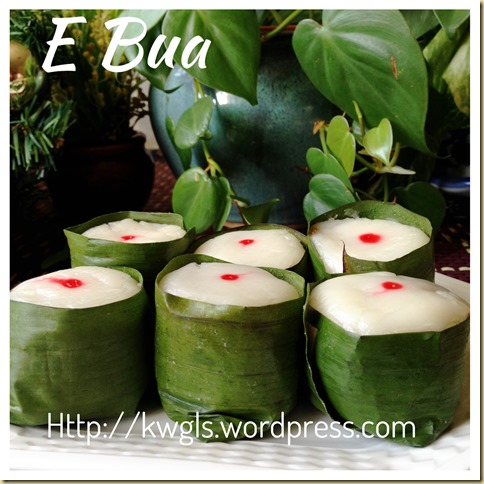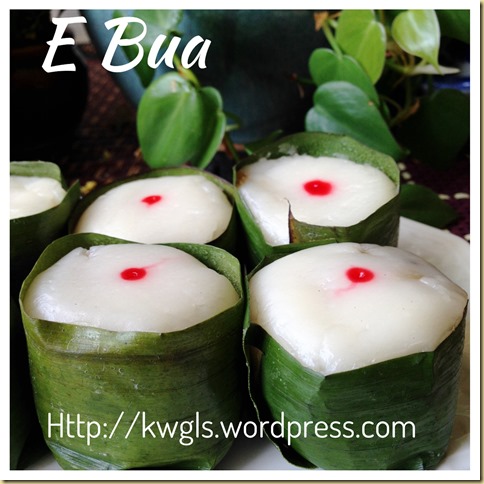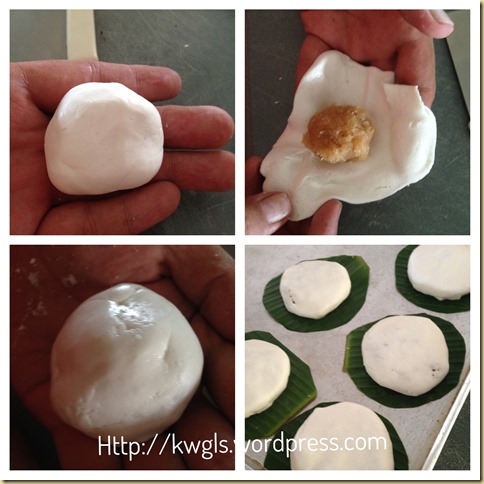Updated post on 26-11-2014
Decided to re-prepared this as the second attempt and adhere as closed to the Hainanese tradition as possible. Slightly changes in the recipe to enhance the texture of the dough and incorporate a new picture of wrapping as required by Hainanese traditions.
INTRODUCTION
First, I have to qualify that I am not a Hainanese descendant and I have never tasted the authentic E Bua (in Hainanese) or Yi Ba (薏粑 in Chinese) or just Hainanese Glutinous Rice Coconut Cake. However, in my home town, Kuching or in Singapore hawker centre, I am very familiar with another common variants of this cake.
It looks very much like Kuih Koci, another type of Nonya Kuih. Personally, I preferred this than kuih koci as there are some ginger, sesame seeds and groundnuts that create the slight different in taste. If you are interested to understand Kuih Koci, you can refer to this post : Koci, Goci, Kochi, Mendut, Lapek Bugis? I Am Confused–Pandan Kuih Koci (锥形香兰椰丝糯米滋)
Authentic E-Bua should have banana leaves wrapped along the side of the cakes and the fillings were dark coloured shredded coconut, simmer with coconut sugar and have grounded peanut, sesame seeds and pounded ginger added to it. Whereas the common hawker version is just placing the cake in a piece of banana leaves without wrapping the sides, and most of the time, the filling is just sweeten white coloured shredded coconut. Some stalls may use coconut sugar too.
This is the recipe for the simpler hawker version. However, I have also listed out all the other ingredients that is required for an authentic E-Bua. Depending on the purpose of your preparation, for normal home consumption, I would think that the hawker version is adequate whereas for big festivals, you may want to consider the authentic version. Hainanese prepared the authentic version for big occasions such as marriage ceremony, baby showers and etc..
Experts looking at my cake will know that my cakes were over steamed. Yes, I have over steamed for additional 5 minutes. Instead of the 10 minutes, I have forgot to look at my watch and steamed for 15 minutes instead. The effect is the E-Bua skins were not smooth and the shape is not round. So, readers have to remember the steaming time is very important and any over steaming will ruined your day’s effort.
I have decided to issue the report because after I posted in Facebook Group, quite a number of members are interested in preparing this cake. Many told me that they missed the cake and wanted me to share the recipe. I have taken the recipe from YUMMY HAINANESE COCONUT KUEH. In this post, you can see the pictures of the authentic version of E-Bua and its fillings.
WHAT IS REQUIRED
Recipe adapted from: YUMMY HAINANESE COCONUT KUEH
Servings: About 24 5 cm diameter size Coconut Kuih
Dough
-
500350 grams of glutinous rice flour (糯米粉) -
150 grams of rice flour (粘米粉)
-
200 grams of coconut milk (one package) (椰奶)
-
300200 grams of warm to hot water (温水) -
100 grams of sugar (白糖)
-
50 grams of cooking oil (食用油)
-
Pinches of salt (少许盐巴)
Fillings
-
Ginger – 1 pieces of about 1 cm – pounded (姜)
-
300 grams of grated coconut (新鲜椰丝)
-
180 grams of Gula Melaka –coconut sugar(椰糖)or Black Sugar 黑糖
-
30 grams of water (水)
-
5 pieces of pandan leaves – bundled (not in picture) (香兰叶)
-
1 tablespoon of plain flour (普通面粉)
-
50 grams of grounded peanuts (not in picture) (花生碎)
-
30 grams of white sesame seeds (not in picture) (白芝麻)
Others:
-
About 24 pieces of banana leaves (6 cm in diameter) – cleaned and lightly greased with cooking oil
-
A few tablespoons of cooking oil for glazing after steaming.
Note that the colour of your filling will very much depends on the type of sugar used. Not all grades of coconut sugar are dark enough. In China, coconut sugar is not used and substitute with brown or dark coloured black sugar.
STEPS OF PREPARATION
-
In a big mixing bowl, put the salt, sugar and glutinous rice flour. Add in the warm to hot water and use the spoon to stir until it form some sticky dough. Add in the coconut milk. Use hand to knead until it form a pliable dough. The dough should be smooth. Add water tablespoons by tablespoons if you find that the dough is too dry. Cover with clingy wrap or wet towel and rest for 20-30 minutes. If you want, you can divide the dough into about 30 – 40 grams each depending on how thin the dough you can manage it.
-
Pound the ginger in the pastel and mortal. Put the coconut sugar or gula melaka. Pound in until small pieces. This process is just to expedite the melting process in the next step. You can use knife to chop if you do not have the pastel and mortal. In a pan under medium heat, add water, gula melaka, pounded ginger and pandan leaves bundle (I did not add in this illustration). Let it boil until all the sugar are melted.
-
Add in the grated coconut and stir until well mixed. Add in the plain flour to thicken the grated coconut. Once well mix, dish up and let it cool before shaping into individual balls of about 30-40 grams. Note that my ratio of dough to filling ratio is 1:1, meaning if dough is 30 grams, filling is also 30 grams. However, feel free to adjust the ratio to the ratio that you are comfortable with.
-
Take a dough ball, slightly flatten it, put a filling ball on the centre. Seal the edges. Shape it again in a round shape. Put on top of a piece of banana leaves. Flattened it slightly. Put some glutinous rice flour on your hand if you find it too sticky.
-
After wrapping the filling, have a piece of banana leaves of 5cm x 12 cm. Wrap the banana leaves surrounded the ball. Tuck in the bottom and reverse back and the wrapping is done. If the leaves are too hard, you can cut some vertical lines on the part to be tucked in and pressed down to facilitate the tucking.
-
Dip a tooth pick in some permitted red colouring and place a small dot on top of the dough.
-
Heat up a steamer with water adequate of steaming for the cake for about 10-15 minutes. Bring to boil and steam the cake under medium heat for 10 minutes. Brush some cooking oil on top of the cake while the cake is warm. Let it cooled completely (about 2-3 hours) before enjoying yourself.
CONCLUSION
This glutinous rice cake is rather common during my childhood day. I love the cake very much because of its sweet coconut fillings. You can use white sugar if you do not have coconut sugar. You can also go until the extend of wrapping the sides of the cakes with banana leaves and putting grounded peanuts and sesame seeds to make it more authentic. Pardon me for the images of over steaming E-Bua.
Hope you like the post today. Cheers and have a nice day.
-
For more recipes, you can refer to my RECIPE INDEX (updated as at 20 November 2014) here and you can follow me at PINTEREST or visit the blog’s FACEBOOK PAGE to keep abreast of my future posts.
-
If you are a Pinterest user and you are interested to have more recipes, you can join or follow this Pinterest Board set up by me where there are more than 2600 recipes worldwide and pinned by various bloggers: FOOD BLOGGERS AND FOODIES UNITED PINTEREST BOARD.




















Pingback: RECIPE INDEX ( Updated on 5 April 2014) | GUAI SHU SHU
Pingback: 15 Local Singapore And Malaysian Kuih and Snack Special Compilation | GUAI SHU SHU
Pingback: hainanese coconut kueh 琼海人气小吃 ~ 海南薏粿 (椰子粿)(ෆ ͒•∘̬• ͒)◞ « Victoria Bakes
Thank you so much.
Pingback: Special Compilation Of Chinese Steamed Cakes And Kuihs (15种华人蒸糕特备汇编) | GUAI SHU SHU
Pingback: RECIPE INDEX ( Updated on 16 AUGUST 2014) | GUAI SHU SHU
You are missing peanuts yo.
My grandmother always puts them in with red sugar
I did say that in the blog that peanut and ginger can be added..
Thanks for sharing, Kenneth, try to reduce the heat when steaming the kuih, may be too high heat, your kuih rised up too much then fell down again, so the “skin” is uneven. I had the same experance when I made other kuih.
Pingback: Koci, Goci, Kochi, Mendut, Lepak Bugis? I Am Confused–Pandan Kuih Koci (锥形香兰椰丝糯米滋) | GUAI SHU SHU
Pingback: 30 Local Singapore And Malaysian Kuih Special Compilation (30 种本地糕点汇编) | GUAI SHU SHU
Pingback: Compilation of Chinese Kuih’s Crust/Skin and Fillings (中国传统糕点皮及馅之汇编) | GUAI SHU SHU